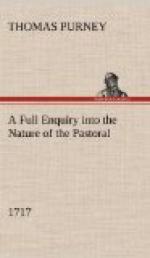I shall only add one Observation on this Head, and proceed. Pastoral admits of Narration and Dialogue, but in Narration we may be greatly more diffuse in our Descriptions than in the Dialogue part of the Piece. For nothing in Poetry is to be preserv’d with more care than probability, especially in Pastoral. Now for a Shepherd to be relating an Accident of Concern, and to dwell on a Description of Place or Person for four or five Lines in the midst, does it not look as if ’twere only Verses written, and not a Tale actually told by the Swain, since in such a Case ’tis natural to hast to the main Point, and not to dwell so particularly on Matters of no Consideration.
I might give several other Reasons for the shortness of Pastoral Descriptions, as that ’tis the manner of Shepherds not to dwell on one Matter so precisely, but to run from one thing to another; Also, that the Reader’s Mind is delighted when it has scope to employ it self; and the like. But the clearness of the Question prevents me.
SECT. 3.
What Pastoral Images will shine most in a Description.
We have just shown which Images are the finest; and ’tis evident that by an accumulation of the best Images is form’d the best Description. ’Tis not here my business particularly to show which Circumstances, in any Description, are best, which worst; ’tis enough, that in general We affirm the most Beautiful to be finest in Pastoral, and the most Sublime in Epick Poetry; which are most Beautiful, and which are most Sublime I have elsewhere shown.
Yet there are several foreign Assistances or Adjuncts, which do greatly add to a beautiful Circumstance; as for Instance; if along with a beautiful Image, we by any means show at once the Happiness and Innocence of the rural Inhabiters, it renders the Circumstance greatly more delightful. This can’t so well be explain’d as by an Instance. Ovid describes PROSERPINA, as she is gathering Flowers in a Meadow among her Play-Fellows, hurried away by PLUTO, in order to her Ravishment. Among the Misfortunes, which that Violence brought upon the Innocent young Creature, this is one;
And oh, out Lap the pretty florets fell.
There is no Circumstance in any Author, nor any one will be ever invented, more proper for Pastoral than this Line: As it contains not only a most beautiful Image, but show’s us at once the Simplicity, and Happiness of the Country, where even such Accidents are accounted Misfortunes.




